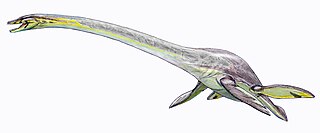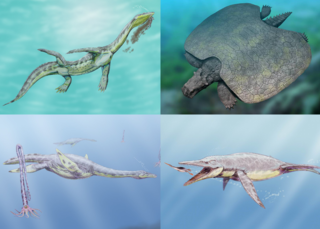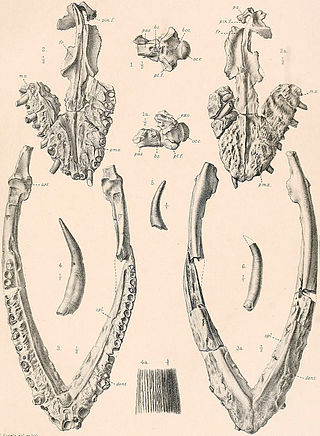
Plesiosauroidea is an extinct clade of carnivorous marine reptiles. They have the snake-like longest neck to body ratio of any reptile. Plesiosauroids are known from the Jurassic and Cretaceous periods. After their discovery, some plesiosauroids were said to have resembled "a snake threaded through the shell of a turtle", although they had no shell.

Plesiosaurus is a genus of extinct, large marine sauropterygian reptile that lived during the Early Jurassic. It is known by nearly complete skeletons from the Lias of England. It is distinguishable by its small head, long and slender neck, broad turtle-like body, a short tail, and two pairs of large, elongated paddles. It lends its name to the order Plesiosauria, of which it is an early, but fairly typical member. It contains only one species, the type, Plesiosaurus dolichodeirus. Other species once assigned to this genus, including P. brachypterygius, P. guilielmiimperatoris, and P. tournemirensis have been reassigned to new genera, such as Hydrorion, Seeleyosaurus and Occitanosaurus.

Kronosaurus is an extinct and potentially dubious genus of short-necked pliosaurs that lived during the Early Cretaceous period in what is now Australia. One species is known, K. queenslandicus, described in 1924 from a partial fossil discovered in Queensland. The rare other fossils traditionally attributed to the genus indicate that the animal should have reached a size approaching 10 meters (33 ft) in length.

The Plesiosauria or Plesiosaurs are an order or clade of extinct Mesozoic marine reptiles, belonging to the Sauropterygia.

Sauropterygia is an extinct taxon of diverse, aquatic reptiles that developed from terrestrial ancestors soon after the end-Permian extinction and flourished during the Triassic before all except for the Plesiosauria became extinct at the end of that period. The plesiosaurs would continue to diversify until the end of the Mesozoic. Sauropterygians are united by a radical adaptation of their pectoral girdle, adapted to support powerful flipper strokes. Some later sauropterygians, such as the pliosaurs, developed a similar mechanism in their pelvis.
Liopleurodon is an extinct genus of large, carnivorous marine reptile belonging to the Thalassophonea, a clade of short-necked pliosaurid plesiosaurs. Liopleurodon lived from the Callovian Stage of the Middle Jurassic to the Kimmeridgian stage of the Late Jurassic Period. It was the apex predator of the Middle to Late Jurassic seas that covered Europe. The largest species, L. ferox, is estimated to have grown up to 6.6 metres (22 ft) in length based on the largest known skull.
The Sundance Sea was an epeiric sea that existed in North America during the mid-to-late Jurassic Period of the Mesozoic Era. It was an arm of what is now the Arctic Ocean, and extended through what is now western Canada into the central western United States. The sea receded when highlands to the west began to rise.

Muraenosaurus is an extinct genus of cryptoclidid plesiosaur reptile from the Oxford Clay of Southern England. The genus was given its name due to the eel-like appearance of the long neck and small head. Muraenosaurus grew up to 5.2 metres (17 ft) in length and lived roughly between 160 Ma and 164 Ma in the Callovian of the middle Jurassic. Charles E. Leeds collected the first Muraenosaurus which was then described by H. G. Seeley. The specimen may have suffered some damage due to the casual style of Charles Leeds’ collection. The first muraenosaur was recovered with pieces missing from the skull and many of the caudal vertebrae absent. Because the animal was described from Charles Leeds’ collection it was given the name Muraenosaurus Leedsi. M. leedsi is the most complete specimen belonging to the genus Muraenosaurus and also the only species that is undoubtedly a member of the genus. Two other species have been tentatively referred to as members of the genus Muraenosaurus: M. reedii and Muraenosaurus beloclis Seeley 1892, which in 1909 became the separate genus Picrocleidus.
Peloneustes is a genus of pliosaurid plesiosaur from the Middle Jurassic of England. Its remains are known from the Peterborough Member of the Oxford Clay Formation, which is Callovian in age. It was originally described as a species of Plesiosaurus by palaeontologist Harry Govier Seeley in 1869, before being given its own genus by naturalist Richard Lydekker in 1889. While many species have been assigned to Peloneustes, P. philarchus is currently the only one still considered valid, with the others moved to different genera, considered nomina dubia, or synonymised with P. philarchus. Some of the material formerly assigned to P. evansi have since been reassigned to "Pliosaurus" andrewsi. Peloneustes is known from many specimens, including some very complete material.

Rhomaleosaurus is an extinct genus of Early Jurassic rhomaleosaurid pliosauroid known from Northamptonshire and from Yorkshire of the United Kingdom. It was first named by Harry Seeley in 1874 and the type species is Rhomaleosaurus cramptoni. It was one of the earliest large marine reptile predators which hunted in the seas of Mesozoic era, with the type species R. cramptoni measuring 6.7–7 metres (22–23 ft) long and weighing 2.1 metric tons. Like other pliosaurs, Rhomaleosaurus fed on ichthyosaurs, ammonites and other plesiosaurs.

Umoonasaurus is an extinct genus of plesiosaur belonging to the family Leptocleididae. This genus lived approximately 115 million years ago during the Late Cretaceous period, in shallow seas covering parts of what is now Australia. It was a relatively small animal around 2.5 metres (8.2 ft) long. An identifying trait of Umoonasaurus is three crest-ridges on its skull.

Plesiopleurodon is an extinct genus of Mesozoic marine reptiles, belonging to Sauropterygia, known from the Late Cretaceous of North America. It was named by Kenneth Carpenter based on a complete skull with a mandible, cervical vertebra, and a coracoid. In naming the specimen, Carpenter noted "Of all known pliosaurs, Plesiopleurodon wellesi most closely resembles Liopleurodon ferox from the Oxfordian of Europe, hence the generic reference." It was initially described as a pliosaur due to it short neck, a common trait of the family, although it is in the order Plesiosauria. However, later exploration into the relationships of both orders indicate that not all pliosaurs have short necks and not all plesiosaurs have long necks.

Megalneusaurus is an extinct genus of large pliosaur that lived in the Sundance Sea during the Kimmeridgian, ~156-152 million years ago, in the Late Jurassic. It was named by paleontologist W. C. Knight in 1895.

Polycotylus is a genus of plesiosaur within the family Polycotylidae. The type species is P. latippinis and was named by American paleontologist Edward Drinker Cope in 1869. Eleven other species have been identified. The name means 'much-cupped vertebrae', referring to the shape of the vertebrae. It lived in the Western Interior Seaway of North America toward the end of the Cretaceous. One fossil preserves an adult with a single large fetus inside of it, indicating that Polycotylus gave live birth, an unusual adaptation among reptiles.

Pachycostasaurus is an extinct Pliosauroid from the Oxford Clay formation of Peterborough, England.

During the time of the deposition of the Niobrara Chalk, much life inhabited the seas of the Western Interior Seaway. By this time in the Late Cretaceous many new lifeforms appeared such as mosasaurs, which were to be some of the last of the aquatic lifeforms to evolve before the end of the Mesozoic. Life of the Niobrara Chalk is comparable to that of the Dakota Formation, although the Dakota Formation, which was deposited during the Cenomanian, predates the chalk by about 10 million years.

This timeline of plesiosaur research is a chronologically ordered list of important fossil discoveries, controversies of interpretation, taxonomic revisions, and cultural portrayals of plesiosaurs, an order of marine reptiles that flourished during the Mesozoic Era. The first scientifically documented plesiosaur fossils were discovered during the early 19th century by Mary Anning. Plesiosaurs were actually discovered and described before dinosaurs. They were also among the first animals to be featured in artistic reconstructions of the ancient world, and therefore among the earliest prehistoric creatures to attract the attention of the lay public. Plesiosaurs were originally thought to be a kind of primitive transitional form between marine life and terrestrial reptiles. However, now plesiosaurs are recognized as highly derived marine reptiles descended from terrestrial ancestors.

Megacephalosaurus is an extinct genus of short-necked pliosaur that inhabited the Western Interior Seaway of North America about 94 to 93 million years ago during the Turonian stage of the Late Cretaceous, containing the single species M. eulerti. It is named after its large head, which is the largest of any plesiosaur in the continent and measures up to 1.75 meters (5.7 ft) in length. Megacephalosaurus was one of the largest marine reptiles of its time with an estimated length of 6–9 meters (20–30 ft). Its long snout and consistently sized teeth suggest that it preferred a diet on smaller-sized prey.
Luskhan is an extinct genus of brachauchenine pliosaur from the Cretaceous of Russia. The type and only species is Luskhan itilensis, named by Valentin Fischer and colleagues in 2017 from a well-preserved and nearly complete skeleton. As an early-diverging brachauchenine, Luskhan consequently exhibits an intermediate combination of traits seen in more basal and more derived pliosaurs. However, Luskhan departs significantly from other pliosaurs in that it exhibits a lack of adaptations in its skull to feeding on large prey; its slender snout, small teeth, and short tooth rows instead indicate a skull adapted for feeding on small, soft prey. With these features, it is the pliosaur that approaches closest to the distantly-related piscivorous polycotylids, having convergently evolved these traits more than 10 million years apart.

Thalattosuchus is an extinct genus of marine crocodyliform that lived in the oceans during the Middle to Late Jurassic. Thalattosuchus was named in 2020. Thalattosuchus was a carnivore that spent much, if not all, its life out at sea. No Thalattosuchus eggs or nests have been discovered, so little is known of the reptile's life cycle, unlike other large marine reptiles of the Mesozoic, such as plesiosaurs or ichthyosaurs which are known to have given birth to live young out at sea. Where Thalattosuchus mated, whether on land or at sea, is currently unknown. The name Thalattosuchus means "sea crocodile".















